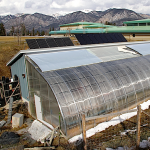 Yes, making your home more energy efficient actually pays. When Congress passed the financial bailout bill late last year, it included a range of federal tax credits and cash gifts for businesses — but also a suite of new and renewed tax credits for individuals who want to make energy efficiency and renewable energy improvements to their homes. When President Obama signed the economic stimulus bill in February, the federal government expanded and extended some of those credits. So what’s in it for homeowners and other regular taxpayers?
Yes, making your home more energy efficient actually pays. When Congress passed the financial bailout bill late last year, it included a range of federal tax credits and cash gifts for businesses — but also a suite of new and renewed tax credits for individuals who want to make energy efficiency and renewable energy improvements to their homes. When President Obama signed the economic stimulus bill in February, the federal government expanded and extended some of those credits. So what’s in it for homeowners and other regular taxpayers?
Alliance to Save Energy Website provides specific details:
For improvements made in 2009 and 2010, you can get an income tax credit of up to $1,500 for installing efficient new windows, insulation, doors, roofs, and heating and cooling equipment in your home. However, efficiency criteria will vary dependant on when these items are “placed in service” (installed).
Who gets it? Individuals who install specific energy-efficient home improvements.
What energy-efficient home improvements are eligible? The overall $1,500 cap can be reached in several ways with the purchase and installation of energy-efficient products that meet certain efficiency criteria:
- Exterior windows: Includes skylights and storm windows.
- Insulation, exterior doors, or roofs: Includes seals to limit air infiltration, such as caulk, weather stripping, and foam sealants, as well as storm doors.
- Central air conditioner, heat pump, furnace, boiler, water heater, or bio gas (e.g. corn) stove: Starting in 2009, geothermal heat pumps are instead eligible for a separate tax credit—see Section 5 below.
Section 6.4 of this document contains the detailed criteria for the products and effective dates (in general only some Energy Star products qualify). Individuals can also search for qualifying heating and cooling products on the Consortium for Energy Efficiency’s web site.
In addition, to be eligible for the federal tax credits:
Windows, doors, insulation, and roofs must be expected to last at least five years (a two-year warranty is sufficient to demonstrate this).
Manufacturers can certify (in packaging or on the company’s web site) which of their products qualify for the tax credit. Retailers, contractors, and manufacturers should be able to help you determine what levels of insulation and what other products qualify.
All the improvements must be installed in or on the taxpayer’s principal residence in the United States. Condo and co-op improvements are apportioned to the owners.
A ‘patch’ to the Alternative Minimum Tax for tax year 2008 and 2009 allows this credit to be claimed by those paying the AMT. It is uncertain if this will be extended to 2010 and beyond.
 How much is the credit? The tax credit amount is now 30 percent of the cost of the measures, including installation costs for heating and cooling equipment, but only product costs for windows, insulation, and other parts of the building “shell.” There is a cap on the credit amount of $1,500 for fiscal years 2009 and 2010 combined; thus the credit applies to up to $5,000 in total costs.
How much is the credit? The tax credit amount is now 30 percent of the cost of the measures, including installation costs for heating and cooling equipment, but only product costs for windows, insulation, and other parts of the building “shell.” There is a cap on the credit amount of $1,500 for fiscal years 2009 and 2010 combined; thus the credit applies to up to $5,000 in total costs.
When is it available? The home improvements tax credit applies for improvements “placed in service” from January 1, 2009, through December 31, 2010. However, modifications to the criteria were made on products placed in service after February 17, 2009, the date of ARRA passage: products installed through February 16, 2009 are subject to the older criteria, but from February 17th onwards the new stricter criteria apply – except for exterior windows and skylights. The IRS defines “placed in service” as when the products or materials are ready and available for use – this would generally refer to the installation, not the purchase.
Exterior windows and skylights placed in service from January 1 through May 31, 2009 require only existing manufacturer certifications and Energy Star labels, as updates to criteria based on ARRA were not yet available during that timeframe. From June 1, 2009 onwards, the new, more stringent criteria apply. For more information on the June 1 window and skylight issue, see the IRS guidance and press release.
The credits were not available in 2008, but an earlier credit, with different criteria and credit amounts, was available in 2006 and 2007 (credits claimed in these past years do not count toward the $1500 cap).
What do I need to do to get the tax credit? You will need to file IRS Form 5695 with your taxes. In addition, you will need to keep at least receipts proving that you purchased the improvements and a copy of the manufacturer’s certification. Accountants and tax advisors should also be able to provide more guidance.
Guidance for Nonbusiness Energy Property Credit: IRS Notice 2009-53, issued June 1, 2009, provides guidance regarding ‘nonbusiness energy property,’ superseding previous IRS guidance in light of recent changes to the credits. It also clarifies some regulations related to items eligible for the credit and manufacturers’ certification of eligible products. This notice also includes transition rules to provide taxpayers with guidance concerning the interaction of the effective date and timing provisions of the Energy Policy Act, the Energy Improvement and Extension Act, and the American Recovery and Reinvestment Act. The publication of this notice provides specific information that taxpayers and manufacturers can rely upon in claiming the credit or certifying eligible products.
Note that the tax credit applies only to equipment, not labor. If you want even more specific info, visit the Energy Star Website.
 New Passive Solar Greenhouse Design Maximizes Solar Inputs and Reduces Energy Waste
New Passive Solar Greenhouse Design Maximizes Solar Inputs and Reduces Energy Waste How to Save Energy With Radiant Floor Heating
How to Save Energy With Radiant Floor Heating Qatar is Building First Passive House Project but is There Hidden Agenda Behind It?
Qatar is Building First Passive House Project but is There Hidden Agenda Behind It?